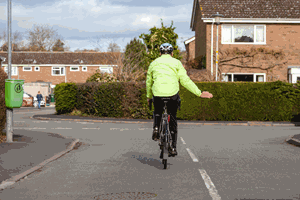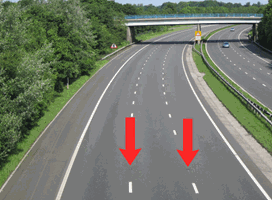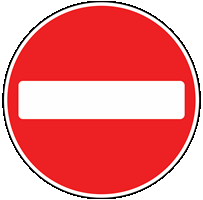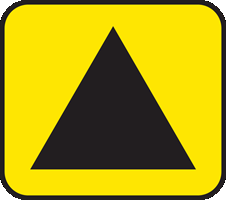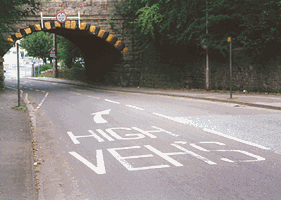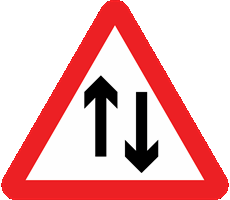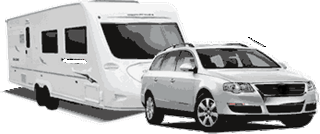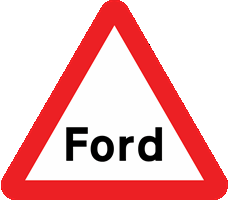You have 57 minutes to answer 50 multiple choice theory test questions. You need to answer at least 43 out of 50 questions correctly to pass. You can review your answer after each question or you can review all of your answers at the end of the test. Best of luck!
Test Quick View
Click on an answer to view the correct choice along with the explanation.
Correct Answer: A, D
Explanation: Your tyres are your only contact with the road so it is very important to ensure that they are free from defects, have sufficient tread depth and are correctly inflated. Correct tyre pressures help reduce the risk of skidding and provide a safer and more comfortable drive or ride.
Explanation: Your tyres are your only contact with the road so it is very important to ensure that they are free from defects, have sufficient tread depth and are correctly inflated. Correct tyre pressures help reduce the risk of skidding and provide a safer and more comfortable drive or ride.
Correct Answer: D
Explanation: Keep well back and allow the cyclist room to take up the correct position for the turn. Don't get too close behind or try to squeeze past.
Explanation: Keep well back and allow the cyclist room to take up the correct position for the turn. Don't get too close behind or try to squeeze past.
3. A driver pulls out of a side road in front of you. You have to brake hard. You should
Mark one answer
B
C
D
Correct Answer: B
Explanation: Where there are a number of side roads, be alert. Be especially careful if there are a lot of parked vehicles because they can make it more difficult for drivers emerging to see you. Try to be tolerant if a vehicle does emerge and you have to brake quickly. Don't react aggressively.
Explanation: Where there are a number of side roads, be alert. Be especially careful if there are a lot of parked vehicles because they can make it more difficult for drivers emerging to see you. Try to be tolerant if a vehicle does emerge and you have to brake quickly. Don't react aggressively.
Correct Answer: B, D, E
Explanation: Pedestrians and riders on two wheels can be harder to see than other road users. Make sure you keep a look-out for them, especially at junctions. Good effective observation, coupled with appropriate action, can save lives.
Explanation: Pedestrians and riders on two wheels can be harder to see than other road users. Make sure you keep a look-out for them, especially at junctions. Good effective observation, coupled with appropriate action, can save lives.
5. You are following a large lorry on a wet road. Spray makes it difficult to see. You should
Mark one answer
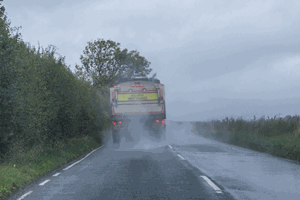
B
C
D
Correct Answer: A
Explanation: Large vehicles may throw up a lot of spray when the roads are wet. This will make it difficult for you to see ahead. Dropping back further will
- move you out of the spray and allow you to see further,
- increase your separation distance. It takes longer to stop when the roads are wet and you need to allow more room.
- Don't, follow the vehicle in front too closely,
- overtake, unless you can see and are sure that the way ahead is clear.
Explanation: Large vehicles may throw up a lot of spray when the roads are wet. This will make it difficult for you to see ahead. Dropping back further will
- move you out of the spray and allow you to see further,
- increase your separation distance. It takes longer to stop when the roads are wet and you need to allow more room.
- Don't, follow the vehicle in front too closely,
- overtake, unless you can see and are sure that the way ahead is clear.
B
C
D
E
Correct Answer: A, B
Explanation: Only overtake the vehicle in front if it's really necessary. At night the risks are increased due to the poor visibility. Don't overtake if there's a possibility of
- road junctions,
- bends ahead,
- the brow of a bridge or hill, except on a dual carriageway,
- pedestrian crossings,
- double white lines ahead,
- vehicles changing direction,
- any other potential hazard.
Explanation: Only overtake the vehicle in front if it's really necessary. At night the risks are increased due to the poor visibility. Don't overtake if there's a possibility of
- road junctions,
- bends ahead,
- the brow of a bridge or hill, except on a dual carriageway,
- pedestrian crossings,
- double white lines ahead,
- vehicles changing direction,
- any other potential hazard.
Correct Answer: C
Explanation: On motorways reflective studs are located into the road to help you in the dark and in conditions of poor visibility. Amber-coloured studs are found on the right-hand edge of the main carriageway, next to the central reservation.
Explanation: On motorways reflective studs are located into the road to help you in the dark and in conditions of poor visibility. Amber-coloured studs are found on the right-hand edge of the main carriageway, next to the central reservation.
Correct Answer: D
Explanation: White studs are found between the lanes on motorways. The light from your headlights is reflected back and this is especially useful in bad weather, when visibility is restricted.
Explanation: White studs are found between the lanes on motorways. The light from your headlights is reflected back and this is especially useful in bad weather, when visibility is restricted.
9. There is a tractor ahead of you. You wish to overtake but you are NOT sure if it is safe to do so. You should
Mark one answer
B
C
D
Correct Answer: B
Explanation: Never overtake if you're not sure whether it's safe. Can you see far enough down the road to ensure that you can complete the manoeuvre safely? If the answer is no, DON'T GO
Explanation: Never overtake if you're not sure whether it's safe. Can you see far enough down the road to ensure that you can complete the manoeuvre safely? If the answer is no, DON'T GO
Correct Answer: A
Explanation: When you want to go straight on at a roundabout, don't signal as you approach it, but indicate left just after you pass the exit before the one you wish to take.
Explanation: When you want to go straight on at a roundabout, don't signal as you approach it, but indicate left just after you pass the exit before the one you wish to take.
Correct Answer: B, C
Explanation: Toucan crossings are similar to pelican crossings but there is no flashing amber phase. Cyclists share the crossing with pedestrians and are allowed to cycle across when the green cycle symbol is shown.
Explanation: Toucan crossings are similar to pelican crossings but there is no flashing amber phase. Cyclists share the crossing with pedestrians and are allowed to cycle across when the green cycle symbol is shown.
Correct Answer: A
Explanation: No entry' signs are used in places such as one-way streets to prevent vehicles driving against the traffic. To ignore one would be dangerous, both for yourself and other road users, as well as being against the law.
Explanation: No entry' signs are used in places such as one-way streets to prevent vehicles driving against the traffic. To ignore one would be dangerous, both for yourself and other road users, as well as being against the law.
Correct Answer: D
Explanation: Catalytic converters are designed to reduce a large percentage of toxic emissions. They work more efficiently when the engine has reached its normal working temperature.
Explanation: Catalytic converters are designed to reduce a large percentage of toxic emissions. They work more efficiently when the engine has reached its normal working temperature.
Correct Answer: A
Explanation: When a diversion route has been put in place, drivers are advised to follow a symbol which may be a triangle, square, circle or diamond shape on a yellow background.
Explanation: When a diversion route has been put in place, drivers are advised to follow a symbol which may be a triangle, square, circle or diamond shape on a yellow background.
Correct Answer: A, B, E
Explanation: Other traffic will have to pull out to pass you. They may have to use the other side of the road, and if you park near the brow of a hill, they may not be able to see oncoming traffic. It's important not to park at or near a bus stop as this could inconvenience passengers, and may put them at risk as they get on or off the bus. Parking near a junction could restrict the view for emerging vehicles.
Explanation: Other traffic will have to pull out to pass you. They may have to use the other side of the road, and if you park near the brow of a hill, they may not be able to see oncoming traffic. It's important not to park at or near a bus stop as this could inconvenience passengers, and may put them at risk as they get on or off the bus. Parking near a junction could restrict the view for emerging vehicles.
Correct Answer: A
Explanation: Oncoming large vehicles may need to move to the middle of the road so that they can pass safely under the bridge. There will not be enough room for you to continue and you should be ready to stop and wait.
Explanation: Oncoming large vehicles may need to move to the middle of the road so that they can pass safely under the bridge. There will not be enough room for you to continue and you should be ready to stop and wait.
Correct Answer: D
Explanation: Traffic calming measures such as road humps, chicanes and narrowings are intended to slow you down. Maintain a reduced speed until you reach the end of these features. They are there to protect pedestrians. Kill your speed!
Explanation: Traffic calming measures such as road humps, chicanes and narrowings are intended to slow you down. Maintain a reduced speed until you reach the end of these features. They are there to protect pedestrians. Kill your speed!
Correct Answer: A
Explanation: You MUST stop if there are red lights flashing above every lane on the motorway. However, if any of the other lanes do not show flashing red lights or red cross you may move into that lane and continue if it is safe to do so.
Explanation: You MUST stop if there are red lights flashing above every lane on the motorway. However, if any of the other lanes do not show flashing red lights or red cross you may move into that lane and continue if it is safe to do so.
Correct Answer: B
Explanation: You will see this sign if there has been an incident ahead and the motorway is closed. You MUST obey the sign. Make sure that you prepare to leave as soon as you see the warning sign. Don't pull over at the last moment or cut across other traffic.
Explanation: You will see this sign if there has been an incident ahead and the motorway is closed. You MUST obey the sign. Make sure that you prepare to leave as soon as you see the warning sign. Don't pull over at the last moment or cut across other traffic.
Correct Answer: A
Explanation: STOP signs are situated at junctions where visibility is restricted or there is heavy traffic. They MUST be obeyed. You MUST stop.Take good all-round observation before moving off.
Explanation: STOP signs are situated at junctions where visibility is restricted or there is heavy traffic. They MUST be obeyed. You MUST stop.Take good all-round observation before moving off.
Correct Answer: D
Explanation: This sign may be at the end of a dual carriageway or a one-way street. It is there to warn you of oncoming traffic.
Explanation: This sign may be at the end of a dual carriageway or a one-way street. It is there to warn you of oncoming traffic.
22. You are travelling on a motorway. A red cross is shown above the hard shoulder. What does this mean?
Mark one answer
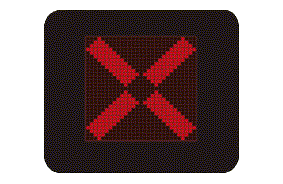
B
C
D
Correct Answer: A
Explanation: When a red cross is shown above the hard shoulder it should only be used for breakdowns or emergencies. Within Active Traffic Management (ATM) areas the hard shoulder may sometimes be used as a running lane. Speed limit signs directly above the hard shoulder will show that it's open.
Explanation: When a red cross is shown above the hard shoulder it should only be used for breakdowns or emergencies. Within Active Traffic Management (ATM) areas the hard shoulder may sometimes be used as a running lane. Speed limit signs directly above the hard shoulder will show that it's open.
Correct Answer: A
Explanation: It's a serious offence to drive without insurance. As well as an unlimited fine, you may be disqualified or incur penalty points.
Explanation: It's a serious offence to drive without insurance. As well as an unlimited fine, you may be disqualified or incur penalty points.
24. You see a pedestrian with a dog. The dog has a yellow or burgundy coat. This especially warns you that the pedestrian is
Mark one answer
B
C
D
Correct Answer: B
Explanation: Take extra care as the pedestrian may not be aware of vehicles approaching.
Explanation: Take extra care as the pedestrian may not be aware of vehicles approaching.
25. You suspect that an injured person may be suffering from shock. What are the warning signs to look for?
Mark one answer
B
C
D
Correct Answer: C
Explanation: Sometimes you may not realise that someone is in shock. The signs to look for are rapid pulse, sweating, pale grey skin and rapid shallow breathing.
Explanation: Sometimes you may not realise that someone is in shock. The signs to look for are rapid pulse, sweating, pale grey skin and rapid shallow breathing.
26. You are on a motorway. You become tired and decide you need to rest. What should you do?
Mark one answer
B
C
D
Correct Answer: A
Explanation: Ideally you should plan your journey so that you have regular rest stops. If you do become tired leave at the next exit, or pull in at a service area if this is sooner.
Explanation: Ideally you should plan your journey so that you have regular rest stops. If you do become tired leave at the next exit, or pull in at a service area if this is sooner.
Correct Answer: D
Explanation: When approaching a tunnel switch on your dipped headlights. Be aware that your eyes might need to adjust to the sudden darkness. You may need to reduce your speed.
Explanation: When approaching a tunnel switch on your dipped headlights. Be aware that your eyes might need to adjust to the sudden darkness. You may need to reduce your speed.
28. At an incident a casualty is not breathing. To start the process to restore normal breathing you should
Mark three answers
B
C
D
E
F
Correct Answer: A, B, D
Explanation: It's important to ensure that the airways are clear before you start mouth to mouth resuscitation. Gently tilt their head back and use your finger to check for and remove any obvious obstruction in the mouth.
Explanation: It's important to ensure that the airways are clear before you start mouth to mouth resuscitation. Gently tilt their head back and use your finger to check for and remove any obvious obstruction in the mouth.
29. You are going through a tunnel. What systems are provided to warn of any incidents, collisions or congestion?
Mark one answer
B
C
D
Correct Answer: D
Explanation: Take notice of any instructions given on variable message signs or by tunnel officials. They will warn you of any incidents or congestion ahead and advise you what to do.
Explanation: Take notice of any instructions given on variable message signs or by tunnel officials. They will warn you of any incidents or congestion ahead and advise you what to do.
B
C
D
E
F
Correct Answer: A, B, D, F
Explanation: You should not allow yourself to be distracted when driving. You need to concentrate fully in order to be safe on the road. Loud music could mask other sounds, such as the audible warning of an emergency vehicle. Any distraction which causes you to take your hands off the steering wheel or your eyes off the road could be dangerous.
Explanation: You should not allow yourself to be distracted when driving. You need to concentrate fully in order to be safe on the road. Loud music could mask other sounds, such as the audible warning of an emergency vehicle. Any distraction which causes you to take your hands off the steering wheel or your eyes off the road could be dangerous.
31. You are driving in freezing conditions. What should you do when approaching a sharp bend?
Mark two answers
B
C
D
E
Correct Answer: A, E
Explanation: Harsh use of the accelerator, brakes or steering are likely to lead to skidding, especially on slippery surfaces. Avoid steering and braking at the same time. In icy conditions it's very important that you constantly assess what's ahead, so that you can take appropriate action in plenty of time.
Explanation: Harsh use of the accelerator, brakes or steering are likely to lead to skidding, especially on slippery surfaces. Avoid steering and braking at the same time. In icy conditions it's very important that you constantly assess what's ahead, so that you can take appropriate action in plenty of time.
32. You are driving towards this level crossing. What would be the first warning of an approaching train?
Mark one answer

B
C
D
Correct Answer: A
Explanation: The steady amber light will be followed by twin flashing red lights that mean you must stop. An alarm will also sound to alert you to the fact that a train is approaching.
Explanation: The steady amber light will be followed by twin flashing red lights that mean you must stop. An alarm will also sound to alert you to the fact that a train is approaching.
33. If you are feeling tired it is best to stop as soon as you can. Until then you should
Mark one answer
B
C
D
Correct Answer: A
Explanation: If you're going on a long journey plan your route before you leave. This will help you to be decisive at intersections and junctions, plan rest stops and have an idea of how long the journey will take.Make sure your vehicle is well-ventilated to stop you becoming drowsy. You need to maintain concentration so that your judgement is not impaired.
Explanation: If you're going on a long journey plan your route before you leave. This will help you to be decisive at intersections and junctions, plan rest stops and have an idea of how long the journey will take.Make sure your vehicle is well-ventilated to stop you becoming drowsy. You need to maintain concentration so that your judgement is not impaired.
Correct Answer: C
Explanation: The speed limit is reduced for vehicles towing caravans and trailers, to lessen the risk of the outfit becoming unstable. Due to the increased weight and size of the vehicle and caravan combination, you should plan well ahead. Be extra-careful in windy weather, as strong winds could cause a caravan or large trailer to snake from side to side.
Explanation: The speed limit is reduced for vehicles towing caravans and trailers, to lessen the risk of the outfit becoming unstable. Due to the increased weight and size of the vehicle and caravan combination, you should plan well ahead. Be extra-careful in windy weather, as strong winds could cause a caravan or large trailer to snake from side to side.
Correct Answer: D
Explanation: Don't forget to put your seat belt back on when you've finished reversing.
Explanation: Don't forget to put your seat belt back on when you've finished reversing.
Correct Answer: C, E
Explanation: Try not to react by applying the brakes harshly. This could lead to further loss of steering control. Indicate your intention to pull up at the side of the road and roll to a stop.
Explanation: Try not to react by applying the brakes harshly. This could lead to further loss of steering control. Indicate your intention to pull up at the side of the road and roll to a stop.
Correct Answer: D
Explanation: We are all responsible for the environment we live in. If each driver takes responsibility for conserving fuel, together it will make a difference.
Explanation: We are all responsible for the environment we live in. If each driver takes responsibility for conserving fuel, together it will make a difference.
Correct Answer: D
Explanation: Your vehicle should have a warning light on the dashboard which illuminates when the fog lights are being used. You need to be familiar with the layout of your dashboard so you are aware if they have been switched on in error, or you have forgotten to switch them off.
Explanation: Your vehicle should have a warning light on the dashboard which illuminates when the fog lights are being used. You need to be familiar with the layout of your dashboard so you are aware if they have been switched on in error, or you have forgotten to switch them off.
Correct Answer: D
Explanation: When visibility is seriously reduced, switch on your fog lights if you have them fitted. It is essential not only that you can see ahead, but also that other road users are able to see you.
Explanation: When visibility is seriously reduced, switch on your fog lights if you have them fitted. It is essential not only that you can see ahead, but also that other road users are able to see you.
40. You are driving on a wet road. You have to stop your vehicle in an emergency. You should
Mark one answer
B
C
D
Correct Answer: C
Explanation: As you drive, look well ahead and all around so that you're ready for any hazards that might occur. There may be occasions when you have to stop in an emergency. React as soon as you can whilst keeping control of the vehicle.
Explanation: As you drive, look well ahead and all around so that you're ready for any hazards that might occur. There may be occasions when you have to stop in an emergency. React as soon as you can whilst keeping control of the vehicle.
41. You are driving in heavy rain. Your steering suddenly becomes very light. You should
Mark one answer
B
C
D
Correct Answer: C
Explanation: If the steering becomes light in these conditions it is probably due to a film of water that has built up between your tyres and the road surface. Easing off the accelerator should allow your tyres to displace the film of water and they should then regain their grip on the road.
Explanation: If the steering becomes light in these conditions it is probably due to a film of water that has built up between your tyres and the road surface. Easing off the accelerator should allow your tyres to displace the film of water and they should then regain their grip on the road.
Correct Answer: C
Explanation: Having your car registration number etched on all your windows is a cheap and effective way to deter professional car thieves.
Explanation: Having your car registration number etched on all your windows is a cheap and effective way to deter professional car thieves.
Correct Answer: C
Explanation: Concentration and good judgement are needed at all times to be a good, safe driver. Don't put yourself or others at risk by drinking and driving.
Explanation: Concentration and good judgement are needed at all times to be a good, safe driver. Don't put yourself or others at risk by drinking and driving.
44. You are driving on a main road. You intend to turn right into a side road. Just before turning you should
Mark one answer
B
C
D
Correct Answer: B
Explanation: A last check in the offside mirror and blind spot will allow you sight of any cyclist or motorcyclist overtaking as you wait to turn.
Explanation: A last check in the offside mirror and blind spot will allow you sight of any cyclist or motorcyclist overtaking as you wait to turn.
Correct Answer: C, E
Explanation: Any load will have an effect on the handling of your vehicle and this becomes worse as you increase the load. Any change in the centre of gravity or weight the vehicle is carrying will affect its braking and handling on bends.You need to be aware of this when carrying passengers, heavy loads, fitting a roof rack or towing a trailer.
Explanation: Any load will have an effect on the handling of your vehicle and this becomes worse as you increase the load. Any change in the centre of gravity or weight the vehicle is carrying will affect its braking and handling on bends.You need to be aware of this when carrying passengers, heavy loads, fitting a roof rack or towing a trailer.
Correct Answer: A
Explanation: You should take extra care when you first encounter trams. You will have to get used to dealing with a different traffic system. Be aware that they can accelerate and travel very quickly and that they cannot change direction to avoid obstructions.
Explanation: You should take extra care when you first encounter trams. You will have to get used to dealing with a different traffic system. Be aware that they can accelerate and travel very quickly and that they cannot change direction to avoid obstructions.
B
C
D
E
Correct Answer: A, D
Explanation: If your rear fog lights are left on when it isn't foggy, the glare they cause makes it difficult for road users behind to know whether you are braking or you have just forgotten to turn off your rear fog lights. This can be a particular problem on wet roads and on motorways. If you leave your rear fog lights on at night, road users behind you are likely to be dazzled and this could put them at risk.
Explanation: If your rear fog lights are left on when it isn't foggy, the glare they cause makes it difficult for road users behind to know whether you are braking or you have just forgotten to turn off your rear fog lights. This can be a particular problem on wet roads and on motorways. If you leave your rear fog lights on at night, road users behind you are likely to be dazzled and this could put them at risk.
48. You have broken down on a two-way road. You have a warning triangle. It should be displayed
Mark one answer
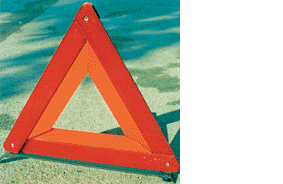
B
C
D
Correct Answer: B
Explanation: If you need to display a warning triangle make sure that it can be clearly seen by other road users. Place it on the same side of the road as the broken down vehicle and away from any obstruction that would make it hard to see.
Explanation: If you need to display a warning triangle make sure that it can be clearly seen by other road users. Place it on the same side of the road as the broken down vehicle and away from any obstruction that would make it hard to see.
Correct Answer: B, C, D, F
Explanation: During the winter the stream is likely to flood. It is also possible that in extremely cold weather it could ice over. Assess the situation carefully before you drive through. If you drive a vehicle with low suspension you may have to find a different route.
Explanation: During the winter the stream is likely to flood. It is also possible that in extremely cold weather it could ice over. Assess the situation carefully before you drive through. If you drive a vehicle with low suspension you may have to find a different route.
50. You have a collision whilst your car is moving. What is the FIRST thing you must do?
Mark one answer
B
C
D
Correct Answer: C
Explanation: If you are in a collision that causes damage or injury to any other person, vehicle, animal or property, by law you MUST STOP. Give your name, the vehicle owner's name and address, and the vehicle's registration number to anyone who has reasonable grounds for requiring them.
Explanation: If you are in a collision that causes damage or injury to any other person, vehicle, animal or property, by law you MUST STOP. Give your name, the vehicle owner's name and address, and the vehicle's registration number to anyone who has reasonable grounds for requiring them.



